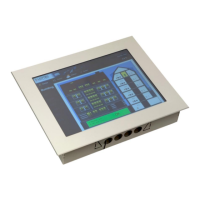L-VIS User Manual 119 LOYTEC
Version 6.2 LOYTEC electronics GmbH
9.5.7.2 Available Pattern Fields
On the left side of the property page is the list of available date pattern fields to choose
from. Since some of these fields are only available for the auto formatter and others only
for raw date patterns, set the desired mode first before adding fields to the pattern. If the
mode is changed later on, an unsupported field in the list will be ignored when using the
auto-formatter and may truncate the output in case of a raw pattern.
Some fields are available in standard form and as a variant designated with (Stand-Alone).
The most important distinction between the standard form and stand-alone form is a
grammatical distinction, for languages that require it. For example, many languages require
that a month name without an associated day number (i.e. an independent form) be in the
basic nominative form, while a month name with an associated day number (as in a
complete date format) should be in a different grammatical form: genitive, partitive, etc.
Here is a list of available date pattern fields with a short explanation and the pattern field
symbol representing the field in the date pattern string:
Calendar Year: The current calendar year (numeric), as defined by the selected
calendar system. This can be for example 2017 for a Gregorian calendar or 29 for
the same year in the Japanese calendar. Pattern symbol y.
Quarter: Quarter number / name. There is also a Stand-Alone variant of this
field, which should be used when only the quarter is shown. Pattern symbol Q or
q (Stand-Alone).
Month: Month number / name. There is also a Stand-Alone variant of this field,
which should be used when only the month is shown. Pattern symbol M or L
(Stand-Alone).
Day: Day of month (numeric). Pattern symbol d.
Day of Week: Day of week number / name. If shown as a number, the first day
of the week is shown as day 1. In cases where the selected locale does not specify
weekday numbers, the formatter may fall back to the abbreviated name. Pattern
symbol e or c (Stand-Alone).
Hour (default): Only available when the auto-formatter is used. Selects the
preferred hour format for the current locale. Pattern symbol j.
Hour w/o Period: Same as the above, but leaves out the day period, if it would
otherwise be used by the current locale (10 instead of 10 pm). Pattern symbol J.
Hour (alternative): Similar to Hour (default), but selects an alternative format,
which is not based on the preferred attribute but the order in which formats are
listed (the first entry is used instead of the preferred one). Pattern symbol C.
Hour [1-12]: Hour from 1-12. Midnight is 12am, Midday is 12pm. Symbol h.
Hour [0-23]: Hour from 0-23. Midnight is 00:00. Symbol H.
Hour [0-11]: Hour from 0-11. Midnight is 0am, Midday is 0pm. Symbol K.
Hour [1-24]: Hour from 1-24. Midnight is 24:00. Symbol k.
Minute: Minute (numeric). Pattern symbol m.
Second: Second (numeric). Pattern symbol s.

